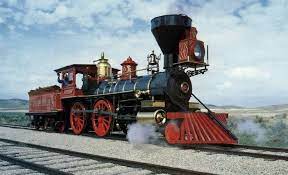
Continued from last week’s post………………
The Union Pacific Railroad had a must easier time of it due to the flat midwestern terrain. A large 20-car work train crawled along the newly-laid tracks to bring supplies and support the army of workers. This train was a combination of factory, hotel, restaurant, hospital and administrative center. It required two locomotives to pull it along. Some cars were divided into offices, storerooms, blacksmith shop, carpenter shop, saddler shop. The rail hands boarded in huge sleeping cars packed with 144 bunks and fed in massive 75-foot long dining cars. Food was good and plentiful: bread, meat and coffee being the staples.
The Central Pacific had less mileage to cover but the Rocky Mountains were extremely difficult to conquer. Remember, all the work was done by blasting with TNT and then with the workers’ hands. At first, labor was scarce and expensive and unemployed immigrants were quickly snapped up by railroad recruiters. “The solution to this labor shortage lay not across the Atlantic but the Pacific,” wrote David Norris in his publication, History of Railroads. China provided thousands of men willing to travel over the ocean to work on the railroad; Chinese recruiting began in 1865 and soon grew to over 10,000 men…… who, being Chinese, were paid $31.00 per month instead of $45.00 for whites.
The worst part of the route for the Central Pacific was the Summit Tunnel over Donner Pass. This project took two full years and in the winter the workers had to dig through tunnels of deep snow just to reach the work site.
The sunny May day in 1869 when the two rail lines finally converged at Promontory Summit in Utah was indeed a milestone and reason to celebrate but the photos of the day omit the details of the full story. In those historic photos, you’ll see no Black or Chinese faces….. these ethnic workers were given no credit for their sacrifices on that auspicious day.
Jumping ahead, the Pullman sleeper car was the brain child of George Pullman who, after being “tormented during a jolting and uncomfortable ride in an overnight passenger car,” turned his mind to a solution and came up with a way to improve overnight rail travel. By 1869, his Pullman sleeper cars were running coast to coast on the new combined Union & Central Pacific Railroads.